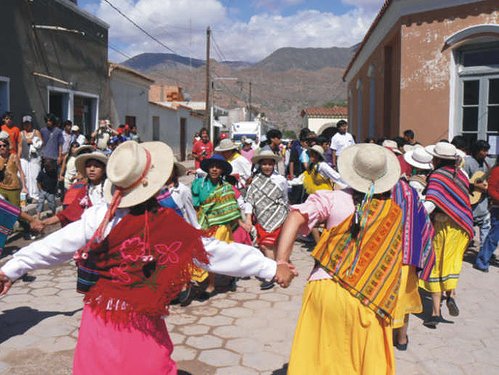Carnavalito on:
[Wikipedia]
[Google]
[Amazon]
 The ''Carnavalito'' () is a traditional indigenous dance from the Argentinian ''
The ''Carnavalito'' () is a traditional indigenous dance from the Argentinian ''
 The ''Carnavalito'' () is a traditional indigenous dance from the Argentinian ''
The ''Carnavalito'' () is a traditional indigenous dance from the Argentinian ''Altiplano
The Altiplano (Spanish language, Spanish for "high plain"), Collao (Quechuan languages, Quechua and Aymara language, Aymara: Qullaw, meaning "place of the Qulla people, Qulla") or Andean Plateau, in west-central South America, is the most extens ...
'' and ''puna'' regions, usually performed during religious festivities. Its current form is an expression of a syncretism between Pre-Columbian
In the history of the Americas, the pre-Columbian era, also known as the pre-contact era, or as the pre-Cabraline era specifically in Brazil, spans from the initial peopling of the Americas in the Upper Paleolithic to the onset of European col ...
and Spanish colonial culture. It is a collective dance which is joyful in nature.
It was danced in the Americas long before the Spanish arrived. Today, it is still danced in the Argentine
Argentines, Argentinians or Argentineans are people from Argentina. This connection may be residential, legal, historical, or cultural. For most Argentines, several (or all) of these connections exist and are collectively the source of their ...
provinces of Salta
Salta () is the capital and largest city in the Provinces of Argentina, Argentine province of Salta Province, the same name. With a population of 618,375 according to the 2010 census, it is also the List of cities in Argentina, 7th most-populous ...
and Jujuy, as well as in southern Bolivia
Bolivia, officially the Plurinational State of Bolivia, is a landlocked country located in central South America. The country features diverse geography, including vast Amazonian plains, tropical lowlands, mountains, the Gran Chaco Province, w ...
and other Andean
The Andes ( ), Andes Mountains or Andean Mountain Range (; ) are the longest continental mountain range in the world, forming a continuous highland along the western edge of South America. The range is long and wide (widest between 18°S ...
regions of Latin America
Latin America is the cultural region of the Americas where Romance languages are predominantly spoken, primarily Spanish language, Spanish and Portuguese language, Portuguese. Latin America is defined according to cultural identity, not geogr ...
. The music is characterized by the use of instruments such as the quena, siku, charango
The charango is a small Andes, Andean stringed instrument of the lute family, from the Quechua people, Quechua and Aymara people, Aymara populations in the territory of the Altiplano in post-Colonial times, after European stringed instruments we ...
s and the bombo.
Choreography
The dance is set staged in groups or with multiple partners who perform choreographed steps to the beat of the music. The dancers move around the musicians in a row. A woman or a man holding a handkerchief (or a pennant decorated with ribbons) is responsible for directing the choreography. They all sing the same verse or improvisations.Musical characteristics
The ''Carnavalito'' is primarily in a minor pentatonic mode, with simple i - V harmony throughout. However certain other Charangos make use of a vii - III - V - i progression. Certain Carnavalitos have a free, strummed intro by the Charangos player.References
{{reflist Argentine dances Indigenous dances of South America Carnivals in Argentina Carnivals in Bolivia Carnival music